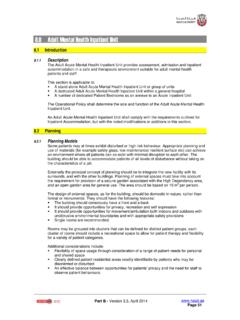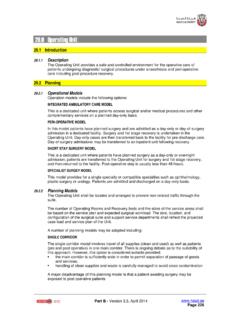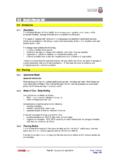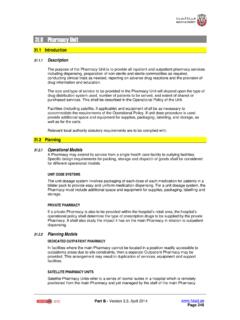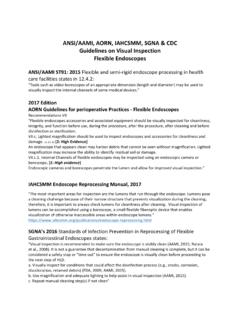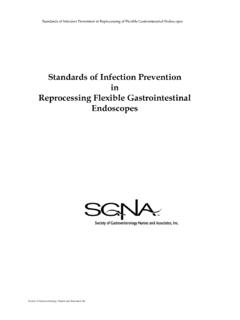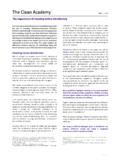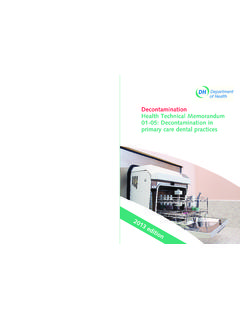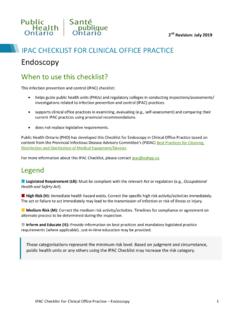Transcription of 19. 0 Endoscopy Unit 19.0 Endoscopy Unit - …
1 19. 0 Endoscopy unit www. shcc. ae Part B Version 1, 2014 Page 161 Endoscopy unit Introduction Description The Endoscopy unit is a dedicated unit for Endoscopy procedures, a minimally invasive surgical or medical procedure utilizing an instrument called an endoscope which is a long flexible tube that has a lens at one end and a fiber optic camera at the other. This allows for the magnification of an image to be projected onto a video screen for viewing and recording. Endoscopy can be used to examine organs or tissue for diagnostic or therapeutic purposes. Endoscopy procedures may involve the taking of biopsies, dilations, retrieval of foreign objects and removal of stones from the bile duct.
2 Procedures undertaken in an Endoscopy unit may include gastrointestinal Endoscopy (such as gastroscopy, colonoscopy, ERCP (Endoscopic Retrograde Cholangiopancreatography), endoscopic ultrasound, bronchoscopy, cystoscopy or ureteroscopy, duodenoscopy, hysteroscopy or other specialties. Endoscopy procedures are generally performed in a controlled aseptic procedure room environment or in an Operating room, using sedation or short acting anesthetic medication. Some procedures, such as ERCP may also involve diagnostic imaging equipment.)
3 Most Endoscopy procedures are performed on a same-day basis. Endoscopy procedures have advantages for both the facility and the patient including: Reduced demand on operating rooms Increased patient throughput as procedures are faster Procedures are less invasive (the endoscope is inserted through a natural opening) resulting in reduced scarring, quick recovery time and rapid discharge. Planning Operational Models The range of options for an Endoscopy unit may include: A dedicated fully self-contained unit within a hospital A unit collocated with the Operating unit with shared facilities A unit collocated with a specialist clinical service such as Gastroenterology or Respiratory Medicine, within a hospital A stand-alone center/Day Surgery centers, fully self-contained.
4 Rural and Remote Endoscopy services. Patients undergoing Endoscopy procedures may be admitted and discharged on the same day, or transferred from and to a referring unit . The Endoscopy unit will generally operate on a long day basis, with admissions from early morning. Procedures undertaken on a sessional basis and discharges/transfers into the evening. Planning Models The configuration of the Endoscopy unit will be dependent on: The procedures performed and the equipment and expertise available The patient population the unit will serve The location of the unit within a hospital, attached to another unit or stand-alone and the ability to share support services.
5 19. 0 Endoscopy unit www. shcc. ae Part B Version 1, 2014 Page 162 The Endoscopy unit should be located with easy access to and from the entry area for patients, visitors, staff and supplies; a ground floor location is desirable. The location within the complex shall permit free access for outpatients and for the transport of inpatients by bed, trolley or wheelchair. The planning of the unit should create an efficient flow of patients, staff and supplies through the unit while maintaining separation of procedure and contaminated areas. Where the Endoscopy unit is not located within the main hospital complex, consideration of the provision for enclosed transfer of patients is advisable.
6 Functional Areas The Endoscopy unit will consist of the following Functional Areas: Entry/Reception including Waiting area for patients and relatives and access for admission of patients Assessment/Preparation area which may include consultation, interview, toilet facilities, patient changing and preparation rooms for pre-procedure treatments Procedure area Recovery areas including first and second stage recovery Discharge lounge with interview space for consultation and access to toilet facilities Reprocessing area including Clean-up/Decontamination, Sterilizing and scope storage and bulk storage areas Staff and support areas.
7 Including Equipment (mobile II or X-Ray machines) and linen bays; in stand-alone Units this will include supply areas and waste holding. Entry/Reception Areas A covered entrance for patient drop-off and collection after surgery shall be provided. The Entry may be a shared facility providing: A reception/information counter or desk Waiting areas that allow for the separation of pediatric and female patients as appropriate Convenient access to wheelchair storage, public toilets and amenities including public telephones. The reception desk should be located to have a view of the entry and must provide for privacy of patient information and records.
8 Waiting areas should be sized according to the expected numbers of patients and support persons and provide for family waiting and patients in wheelchairs or with limited mobility. If pediatric patients are treated in the unit , play areas should be included. Assessment/Preparation Areas Interview and Consultation rooms are required, located with convenient access to the entry and waiting areas to provide for private discussion with patients, review with medical practitioners and anesthetic consultation prior to Endoscopy procedures as required. A patient holding area is required with access to patient changing and toilet facilities.
9 Patients are generally ambulant and may await procedures on a bed or in chairs. Holding areas must provide for male and female separation and patient privacy; screen curtains to bed and chairs spaces is recommended. Storage will be required for patient clothing and valuables. Lockers may be provided or patient clothing and personal items may travel with the patient through each stage of the procedure, recovery and discharge in sealed containers according to the unit Operational Policy and procedures. A Staff Station should be located to provide close supervision of the holding and Preparation areas.
10 19. 0 Endoscopy unit www. shcc. ae Part B Version 1, 2014 Page 163 A Preparation room may be required for patients undergoing Endoscopy procedures, where patients may change and undergo preparation procedures. If provided, the Preparation room should include: Hand basin clinical Bench and cupboards for setting up of procedures Adequate space for procedures equipment trolleys Examination couch and comfortable chair Desk and a computer terminal for review of test results Privacy screening. Patient holding and Preparation room must have close access to patient toilets.
